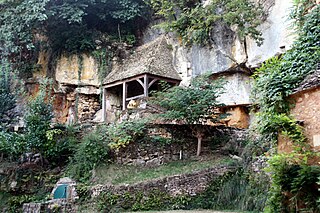Roc de Saint-Cirq
| Roc de Saint-Cirq
|
||
|---|---|---|
|
The entrance to the cave |
||
| Location: | Dordogne , Nouvelle-Aquitaine , France | |
|
Geographic location: |
44 ° 55 '34 " N , 0 ° 58' 3" E | |
|
|
||
| Geology: | Turonium | |
| Overall length: | 13 m | |
Roc de Saint-Cirq is a cave in the French town of Saint-Cirq , municipality of Les Eyzies , in the Dordogne department . It contains incised drawings from the Magdalenian period . Saint-Cirq is located on the right bank of the Vézère , about halfway between Les Eyzies and Le Bugue . The place can be reached via the D 47.
Geography, geology and description
The Roc de Saint-Cirq cave , also known as the Sorcerer's Cave ( French: La Grotte du Sorcier ) or less often as the Cave of Vic , was named after the Roc de Saint-Cirq , a steep wall in limestone of the Turonium northwest above Saint- Cirq. The entrance to the cave is at the left foot of the wall.
The cave is relatively small, it has a rectangular to trapezoidal floor plan with a total length of 13 m and a width of five to six meters. The cave had been used as a wine cellar for centuries; For this purpose, more space was created by lowering the floor.
history
The cave has been known since ancient times, the carvings were only recognized in 1952 by B. Mortureux and his wife, who noticed deeply engraved wild horses and the deep relief of a bison . In the years that followed, Henri Breuil and André Glory carried out further research. Glory made traces of the images. André Leroi-Gourhan worked here in 1965 , followed by Alain Roussot and finally Brigitte and Gilles Delluc in 1981, who made a detailed inventory of the works of art.
Illustrations
Overall, the cave contains 15 mostly incomplete engravings. Several human figures, wild horses, bison, an ibex and abstract symbols were depicted . A special feature is a small statuette of a turtle . Among the human representations is the so-called magician (or shaman), through whom the cave became famous. This incision was made in the rearmost part of the cave on a bulge in the ceiling area. As with other images of the Upper Paleolithic , the face is only drawn in a caricature manner, possibly because of religious backgrounds analogous to the ban on images . The somewhat bulbous wizard is surrounded by an ibex, a bison, a wild horse, a triangular sign and two other human profiles. In the front part of the cave there are more wild horses and a bison without a head.
Age
Absolute age dates for the Roc de Saint-Cirq cave are not available. Stylistic assignments point to Old to Middle Magdalenian, i. H. the works of art were probably made between 17,000 and 15,000 years BP .
Problems with the conservation of the works of art
The relatively easy access to the cave for a long time has damaged the works of art. In addition to a yellowish calcite coating , they are threatened by moisture from algae , moss and lichen . The engravings were then cleaned and brushed, but this led to the surface flaking off in parts. To regulate and stabilize the cave climate, the entrance was walled up and fitted with a metal door. Another measure to protect the cave was to limit the daily flow of visitors. The situation has since stabilized.
UNESCO world cultural heritage
Together with other caves and rock shelters of the Vézère Valley is the cave of Roc Saint-Cirq World Heritage of UNESCO .
Museum etc.
There is a small museum near the cave displaying finds from Saint-Cirq.
Also worth seeing is the cave fortress Pech Saint-Sourd with several underground rooms and so-called cluzeaux (chambers carved into the rock with an opening).
literature
- Delluc, B. & G., Roussot, A. & Roussot-Larroque, J .: Connaître la préhistoire en Périgord . Éditions SUD-OUEST, 1990, ISBN 2-87901-048-9 .
Web links
- Roc de Saint-Cirq - the magician's cave
- The Roc de Saint-Cirq on the website of the Pôle International de la Préhistoire



